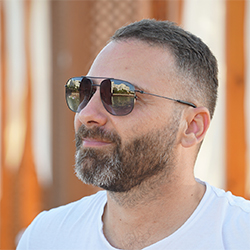10 Most Stunning Monasteries in Crete

Crete is often known for its gorgeous beaches, crazy nightlife and amazing food. But, although these things are all true, you’ll be surprised to know that the most astonishing thing about the island is its impressive monasteries. A wide range of monasteries is spread throughout Crete, each one more beautiful than the other.
From tiny, white-washed chapels to gigantic churches with stunning blue domes, each monastery is unique and offers its own fascinating look at traditional Greek religious architecture.
Listed below are the most stunning monasteries in Crete:
- Preveli Monastery: Preveli Monastery, located in Crete, is an ancient monastery with a rich history dating back to the Venetian period. Comprising two complexes, it played a significant role in national endeavors for independence and education in Crete. Despite past challenges, it remains an influential institution and a popular tourist attraction, offering a glimpse into Rethymno’s history and culture.
- Arkadi Monastery: Arkadi Monastery, situated on a high plateau in Crete, is renowned for its pivotal role in the 1866 revolt. This historic site features strong fortifications and houses valuable icons. It serves as a symbol of resilience and is a popular destination for tourists interested in its rich history.
- Toplou Monastery: Toplou Monastery, also known as Moni Toplou, is a 15th-century monastery located in eastern Crete. Known for its defensive walls and historical significance, it has withstood the test of time. The monastery houses a museum showcasing its World War II history, making it a unique cultural and historical destination.
- Chrisoskalitissa Monastery: Chrisoskalitissa Monastery, perched atop a cliff in Chania, offers stunning sea views and a glimpse into the 17th century. Visitors can explore folklore and Byzantine museums, chapels, and a legendary “golden step.” This monastery provides a cultural and historical experience on the way to Elafonissi Beach.
- Agia Triada “Tzagaroli” Monastery: Agia Triada Monastery, located in Chania, was built in the 17th century and boasts Venetian architectural influence. Surrounded by fortified walls, it features a lush courtyard, chapels, a museum, and a library. This historical site allows visitors to explore its past and enjoy gourmet products.
- Gouverneto Monastery: Gouverneto Monastery, one of Crete’s oldest, was founded in 1537. It showcases fortress-like architecture and offers visitors the chance to explore chapels, including one dedicated to Saint John the Hermit. This historical site is open on select days, providing a unique experience in Crete’s history.
- Gonia Odigitria Monastery: Gonia Odigitria Monastery, near Kolymbari, stands on a high site with breathtaking views. Established in the 9th century and influenced by Venetian architecture, it features fortified walls, a beautiful courtyard, chapels, and a museum. A cannonball from past struggles remains a testament to its history.
- Prodromou Monastery “Korakies”: Prodromou Monastery of Korakies, near other renowned monasteries, is a traditional Easter gathering spot. Its history, though uncertain due to lost documents, survived destruction during the Greek revolt in 1821. Visitors can explore gardens, learn about historical crafts, and enjoy the peaceful surroundings, all for free.
- Vrontisi Monastery: Vrontisi Monastery, located in Crete, is a historical and cultural site with a rich past. Though specific details may vary, it offers visitors a chance to explore its architecture and history, contributing to Crete’s heritage.
- Prodromou Monastery in Korakies: Prodromou Monastery in Korakies is situated in Chania. It opens every day from 8 am to 6 pm. People can tour the monastery, learn about its history and enjoy its tranquil surroundings free of charge. Its location in Chania makes it a prominent spot for both locals and tourists.
- Moni Panagia Odigitria in Sivas: Panagia Odigitria Monastery, located in the Asterousia Mountains near Sivas in southern Crete, is one of the island’s oldest and most historic monasteries. With a fortress-like structure and a rich history, it offers visitors a glimpse into its past, including resistance against occupation.
- St George Monastery in Selinari: St George Monastery in Selinari, near Sissi town, is a testament to Cretan resilience. Dating back to the Second Byzantine period, it faced challenges but stands as a serene and historical site showcasing Byzantine icons and the island’s artistic heritage.
1. Preveli Monastery
One of the must-visit monasteries in Crete is the Preveli Monastery. Surrounded by mountains and a great view of the sea, the Preveli Monastery is an ancient monastery that was believed to have been established during the Venetian period (1205-1669). The monastery is made up of two major building complexes: the first one is the Lower (Kato) Monastery of Saint John the Baptist. The second one is the Rear (Pisso) Monastery of Saint John the Theologian, both of which are still in use today.
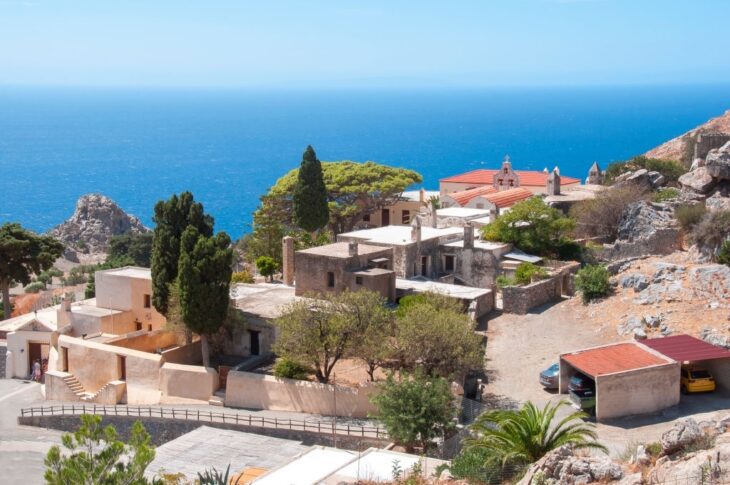
The monastery has a glorious history due to its fellow monks’ strong and leading involvement in all national endeavours for the independence and education of their people. As a result, this monastery is respected and well-known as a major influence in the public life of Crete.
In 1649, the Turks invaded Crete and destroyed numerous church establishments, including the Preveli Monastery. For three centuries, the monastery was regarded as the most important center due to its high position in the local society of Sfakia and Saint Vassilios provinces, where the Turkish invasion force permitted a distinctive system of political tolerance and a restricted state of freedom due to the landscaping territory.
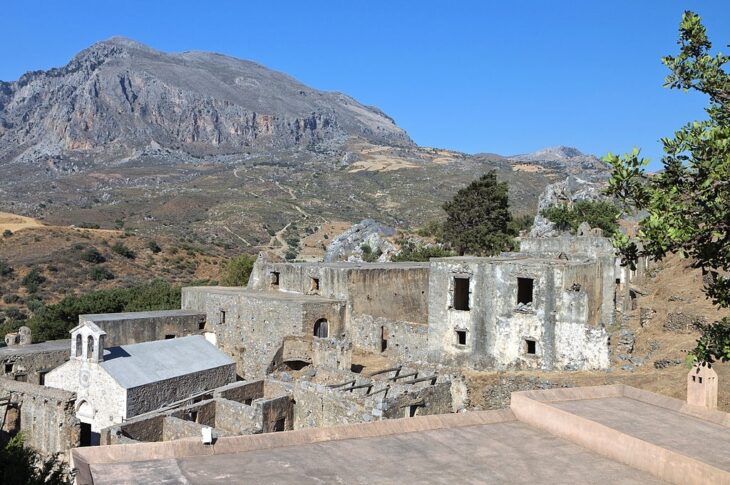
Today, the monastery is a major tourist attraction in Crete. The Lower Monastery has various structures as well as a courtyard. The church of Saint John is located in the center of the yard. The Lower Monastery’s church (Katholikon) includes one aisle, a domed roof and a tower with two huge bells.
On the other hand, the Rear Monastery is situated at the base of a mountain facing the sea. There is a small cemetery with a beautiful chapel and a burial chamber for the monks. The church (Katholikon) is located in the center of the courtyard and has a lovely yet simple exterior.
Preveli Monastery, located in Rethymno, opens its doors to the public at 9 am. In the summer months, visitors can explore until 6 pm, while in winter, the closing time is at 4 pm. The entrance fee to Preveli Monastery is €2.50. For local citizens, entry is free. It’s an inviting and accessible destination all year round for both tourists and locals to appreciate its historic significance in the heart of Rethymno.
2. Arkadi Monastery
The Arkadi Monastery is a site of exceptional historical importance, recognized for the events that occurred during the 1866 revolt. The monastery is situated on the edge of a high plateau. Arkadi is one of the most prominent monuments in Crete and a popular tourist destination.
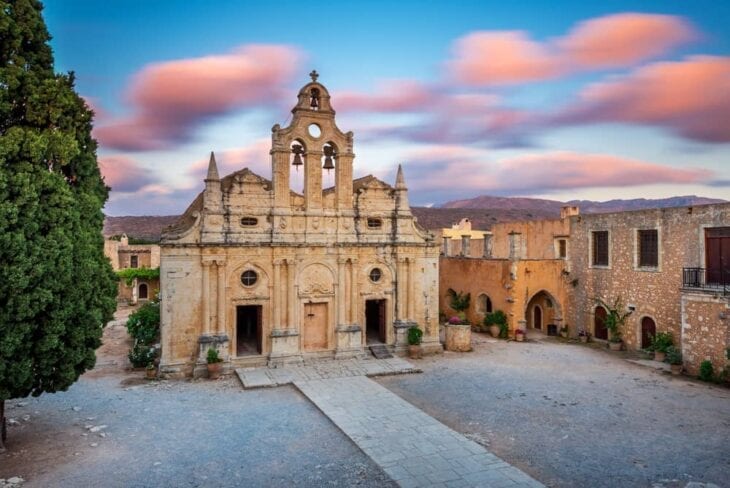
The first fortressing part of the monastery is said to have been built in the 12th century by an Arkadian monk. During the Ottoman invasion, the monks escaped after the Turks raided Arkadi. They were permitted to return and reconstruct the destroyed structures after months of negotiating and vowing fealty to the authorities. Around 100 monks lived within the vicinity and over 200 more in the neighbouring districts. The monks farmed the area and produced wine and olive oil, making it Crete’s most opulent monastery.
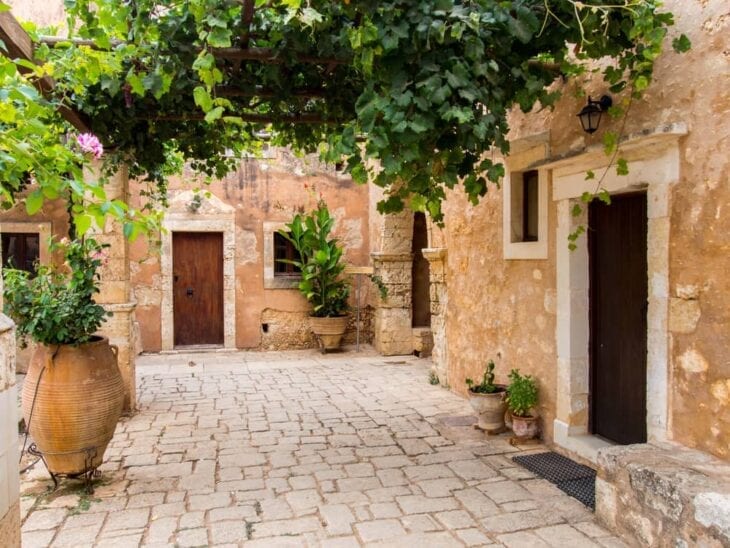
Defensive walls surround Arkadi, giving it the impression of being a fortress. The church, right in the center of the courtyard, is filled with many valuable icons. The paintings were made during the Cretan renaissance period. In addition, a museum is located in the monastery, providing visitors with a further understanding of Arkadi’s history. It includes a collection of documents and Cretan folk art items. You can also see an ossuary right outside the Arkadi monastery, housing the remains of monks who once lived there. Arkadi Monastery is located in the region of Rethymno. Arkadi Monastery welcomes visitors all year round, adjusting its schedule according to the season. Visitors can enter from 9 am. During summer, the monastery closes at 6 pm, while in winter, it closes at 4 pm. Entry into Arkadi Monastery costs €3.00. The reasonably priced tickets make it an affordable option for explorers keen to experience this historic site.
3. Toplou Monastery
Another historical monastery in Crete is the Toplou Monastery. It is often called Moni Toplou by locals It was built in the 15th century and is located in the eastern part of the island on the way to Vai Beach. The monastery is guarded with a 10m high defensive wall, which kept enemy raids at bay. It’s a three-storey structure with a square area of 800 sq m. You can also find 40 rooms and a 33m high bell tower in the area.
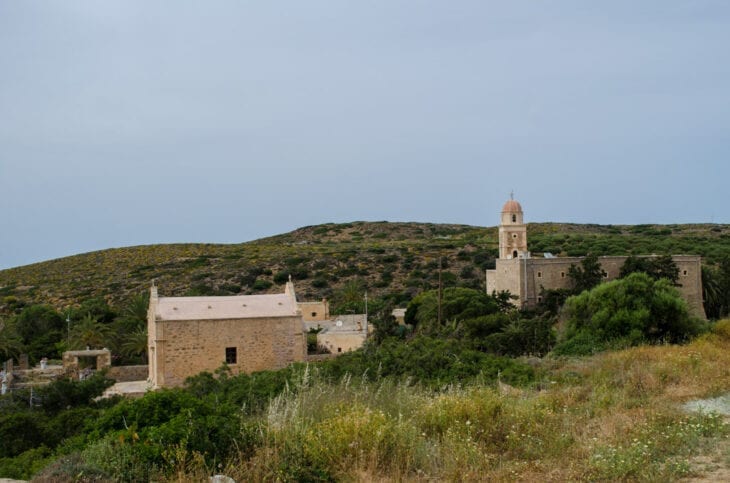
The Toplou Monastery was initially called Panagia Akrotiriani, which means Virgin Mary of the cape. However, during the Turkish period, the name was changed to Toplou since “top” means cannon and a cannon was stationed in the monastery as a line of defence. Throughout the years, the monastery has changed ownership multiple times, but it continued to be of religious significance.
Today, visitors can access the on-site museum to examine the many things that the monastery utilised to fight the Germans. Among them is a wireless radio that is used to connect with allied troops in Egypt. Unfortunately, when German forces discovered the so-called radio, it led to the torture and killing of the abbot and many monks (in the jail of Agia, near Chania).
Toplou Monastery is located in the region of Lasithi. Every day, it opens its gates at 9 am, welcoming visitors until 1 pm, before reopening from 2 pm to 6 pm. Monastery Toplou remains accessible all year, inviting people to explore its historic grounds regardless of the season. A visit is affordable too, with entrance tickets priced at just €2.50. Convenient opening hours and reasonable pricing make it an attractive destination in the Lasithi area.
4. Chrisoskalitissa Monastery
If you’re in Chania, you shouldn’t miss visiting the Chrisoskalitissa Monastery. It is a beautiful ancient building situated on top of a cliff with a gorgeous view. The Chrisoskalitissa monastery is about 71 kilometres (44.12 miles) from Chania center and around 5 kilometres (3.11 miles) from the beach of Elafonissi. The monastery dates back to the 17th century and was built as a fortress, dominating the terrain with a great view of the Libyan sea.
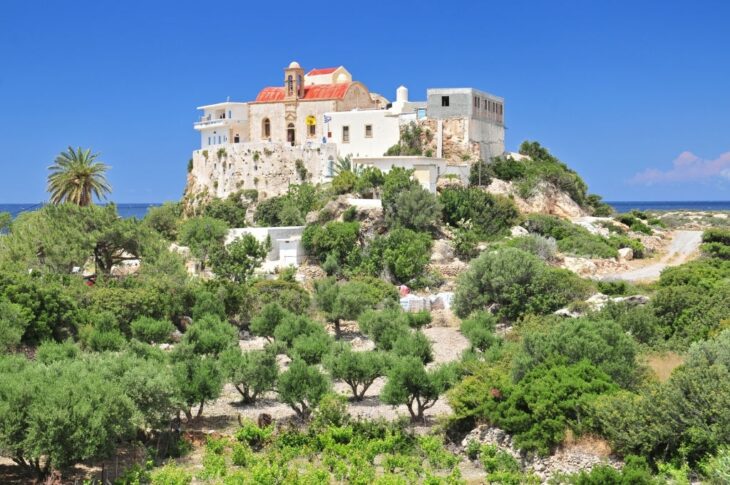
A small folklore museum can be found in the area. The museum showcases tools and equipment used in everyday life of the monks. A Byzantine museum with religious displays is also accessible. The museums can be found immediately after entering the monastery. Panagia Chrisoskalitissa is Greek for “Our Lady of the Golden Step“. The final step of the 98-stepped stairs going up to the church is claimed to be made of gold. However, only the pure of heart can see it.
In addition, two beautiful chapels can also be seen in the area. One is dedicated to the Transfiguration of Christ, while the other is for Saint Gregory the Theologian. Overall, it’s a great place to visit while in Chania and a little detour on the way to Elafonissi. Chrisoskalitissa Monastery is located in Chania. It accepts visitors daily from 7 am to 7:30 pm. The entrance fee is €2.00 per person.
5. Agia Triada Monastery
Another monastery found in Chania is the popular Agia Triada, which means “Holy Trinity“. The monastery was built in the 17th century by two brothers who came from the Venetian Zangaroli family, during the last years of Venetian rule. The monastery’s architectural design was created by one of the founders, Ieremias and was finished by his brother after his death. It is square in form and encircled by strong defensive walls.
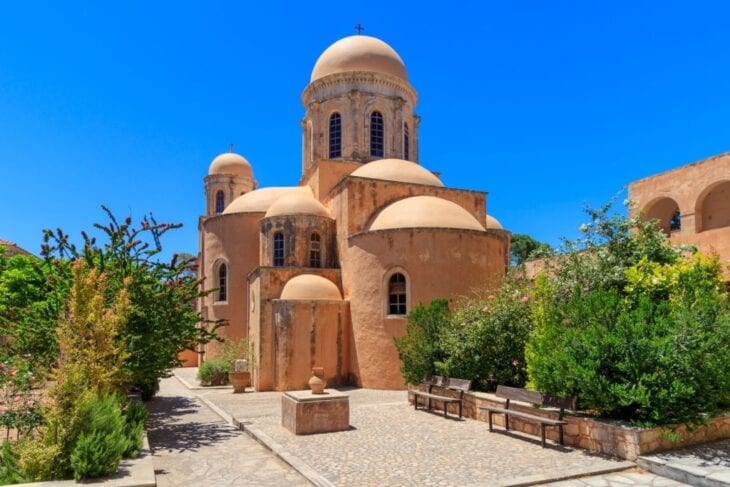
After climbing the formidable steps at the entryway, a vaulted passage leads to a magnificent courtyard with lavish fruit trees and gorgeous flowers, a landscape meticulously maintained by the monastery’s monks. There are two chapels found in the area. One of them is in honour of Saint John the Theologian. It also boasts a distinctive dome with beautiful paintings on the inside. The bell tower is situated directly across from the church and beneath the entryway. You can also see a museum and library, all showcasing various artefacts from the monastery’s history.
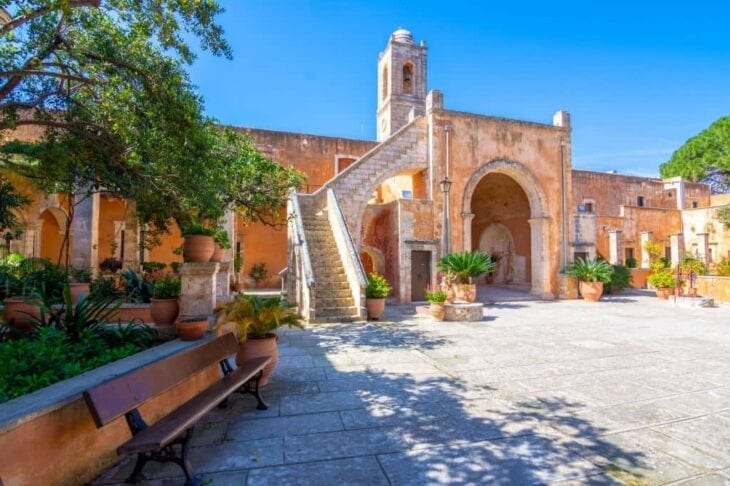
If you wish, you may explore the wine cellars, an antique stone mill and many artefacts from the monastery’s past in the building next to the monastery. You can also sample the monastery’s wines and olive oil, as well as other gourmet specialties, such as their orange balsamic sauce.
Agia Triada Monastery is nestled in the region of Chania. The monastery’s doors open at 8 am, offering visitors an opportunity to explore its grounds. In the summer, Agia Triada Monastery welcomes visitors until 5 pm, while in winter, it closes at 4 pm. Entry to the Agia Triada Monastery is priced at €2.50 per person.
6. Gouverneto Monastery
Gouverneto Monastery is one of Crete’s oldest monasteries, having been founded in 1537. Gouverneto Monastery, also known as Our Lady of the Angels, is located on the Akrotiri Peninsula, about 4 kilometres (2.49 miles) from the Monastery of Agia Triada and 19 kilometres (11.81 miles) north of Chania.
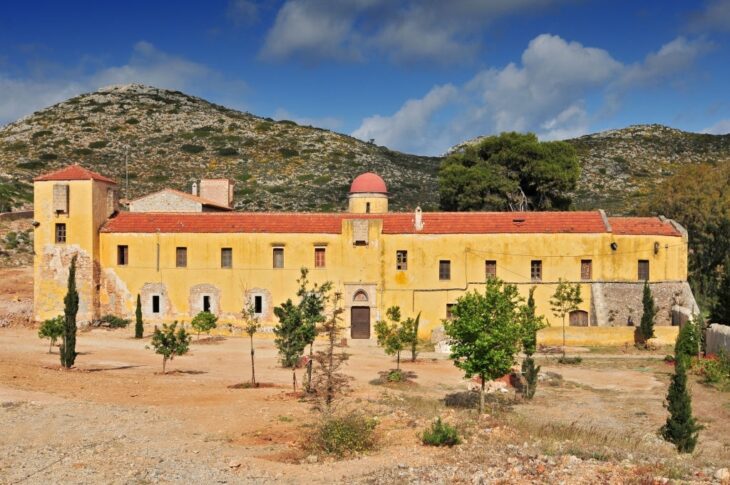
The Gouverneto Monastery is built in the style of a castle, with high towers nestled to protect it against invaders. The monastery’s exterior, in particular, exhibits considerable Venetian influences: it is 40 m x 50 m in size, with around 50 monks’ cells on two levels. There is also a tower in each of the four corners and distinctive embrasures or apertures in the walls. Only two of the towers exist now, although the remnants of the other two may be seen from the courtyard.
There are two small astonishing chapels on either side of the main church. The first one is dedicated to the Ten Saints of Crete, while the other is for Saint John the Hermit. Saint John not only founded Gouverneto monastery, but he also lived in the nearby cave known as Arkoudospilios. The cave is right below the monastery, along the Avlaki Gorge.
Gouverneto Monastery is located 19 km (11,80 miles) north of Chania. On Monday, Tuesday and Thursday, it opens from 9 am to 12 pm and again from 5 pm to 7 pm. On weekends, specifically Saturday and Sunday, it’s accessible from 9 am to 11 am and from 5 pm to 8 pm.
7. Gonia Odigitria Monastery
This easy-to-find monastery of Our Lady of Gonia is located at the base of Cape Rodopo. It is less than 1 km (0,62 miles) from the village of Kolymbari and 25 kilometres (15,53 miles) from the heart of Chania. It’s on a spectacular high site, on a steep hill overlooking the Gulf of Chania. The views of this monastery are enough to take your breath away.
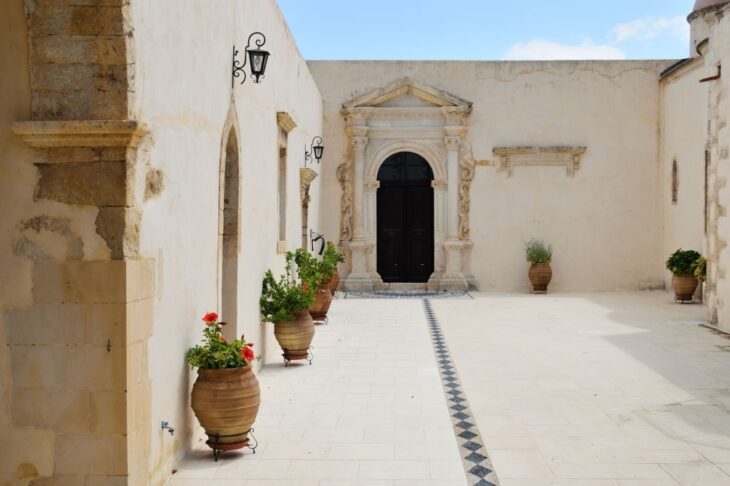
The monastery was first established in the 9th century and was located farther within the peninsula, near the beach of Menies and not far from the historic remnants of a Minoan temple. However, it was rebuilt in its current position during the 15th century, under the control of the Republic of Venice. As a result, Venetian architecture has had a great influence on the construction of the monastery.
The building has fortified walls with a beautiful courtyard facing the church and the cells of the monks. There is also a belfry and a gorgeous fountain found at the entrance. During the Ottoman rule, Gonia, like many other Cretan monasteries, was subjected to repeated attacks and efforts of demolition; in fact, you can still see the remains of an old cannonball on one of the monastery’s walls.
Gonia Odigitria Monastery is based in the region of Chania. It is open for visiting from 9 am to 1 pm and again from 2 pm to 7 pm. A nominal entrance fee of €2.00 is charged for the visit.
8. Prodromou Monastery in Korakies
Prodromou Monastery in Korakies is situated in Chania. It opens every day from 8 am to 6 pm. People can tour the monastery, learn about its history and enjoy its tranquil surroundings free of charge. Its location in Chania makes it a prominent spot for both locals and tourists. Despite the absence of an entrance fee, the allure of the Prodromou Monastery remains high, providing a rich experience at no cost.
The Prodromou Monastery of Korakies is a beautiful monastery located near the mentioned monasteries above. It’s a typical Orthodox Easter gathering spot, where the monastery’s nuns take turns reading the Holy Scripts in a variety of languages all throughout the night. In fact, residents of the Akrotiri peninsula claim this is the most traditional Easter destination in Chania. So if you happen to be in Crete during Easter, this is a must-visit monastery.
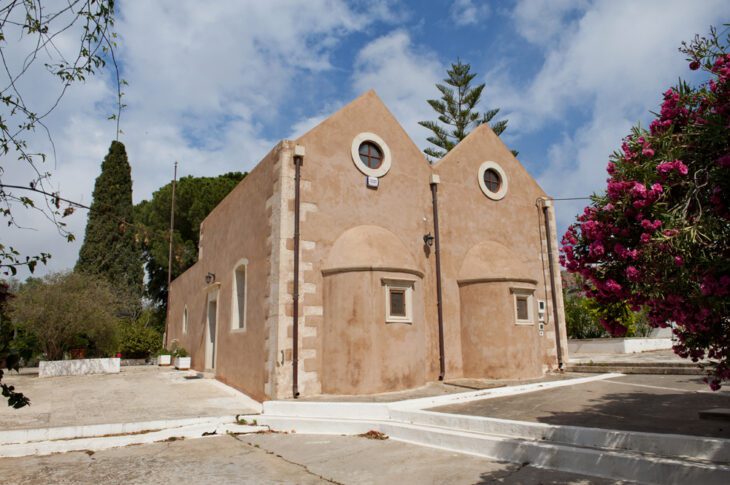
The monastery’s official name is Holy Convent of Saint John the Forerunner. Unfortunately, its founding date is uncertain because the convent’s documents were lost during consecutive Ottoman raids. The convent was heavily destroyed after the Greek revolt against the Ottomans in 1821. The nuns sought safety in other religious structures in the area. In 1867, the monastery reopened, while several of the nuns were involved in many of the Cretan fights against the Turks.
Today, visitors may tour the Korakies monastery and stroll through the beautiful gardens, while learning about historical crafts in the museum. The monastery is home to only a few nuns, who are exceptionally accommodating to foreigners and anyone interested in learning more about the history of Korakies Monastery.
Korakies Monastery is situated in Chania region. It opens every day from 8 am to 6 pm. People can tour the monastery, learn about its history and enjoy its tranquil surroundings free of charge. Its location in Chania makes it a prominent spot for both locals and tourists. Despite the absence of an entrance fee, the allure of the Prodromou Monastery remains high, providing a rich experience at no cost.
9. Moni Panagia Odigitria in Sivas
The Panagia Odigitria Monastery, also known as the Monastery of the Virgin Mary the Guide, is a male Greek Orthodox monastery located in the Asterousia Mountains near the village of Sivas in southern Crete. Considered one of the oldest and most historic monasteries on the island, the monastery has a large estate with multiple chapels and vast land holdings.
The monastery was built in the 14th century, with some icons dating back to the 15th century. It was mentioned in records from 1393 CE. The fortress-style monastery has a two-aisled central church surrounded by various buildings like a bakery, olive mill, wine press, warehouses and cheese cellar. Near the entrance stands the legendary Tower of Xopateras, named for the rebel monk who defended the monastery against Ottoman forces in the 19th century.
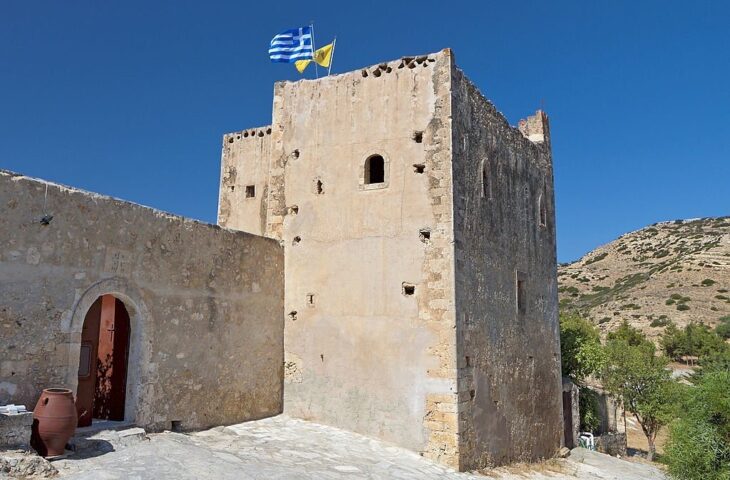
The Panagia Odigitria Monastery has played an important role in Crete’s history of resistance against occupation. During the Cretan Revolt of 1866-69, the monastery was destroyed by Ottoman forces due to the revolutionary activities of the monks. It became a base for rebels and was burned down by Germans during World War II for supplying Greek resistance fighters. After periods of destruction, the monastery has been rebuilt and is still active today.
The historic Panagia Odigitria Monastery is a top attraction in southern Crete for people wanting to see an ancient monastery still active after seven centuries. Its dramatic history is visible in the fortress architecture, yet it remains a solid place to visit.
10. St George Monastery in Selinari
St George Monastery is located in Selinari, just a short distance from Sissi town in Crete. The monastery was constructed between 961 and 1204 during the Second Byzantine period, this monastery has withstood the test of time, despite facing numerous challenges throughout its existence. Pirates burned it down in 1538, but a monk named Nikolaos discovered an icon of Agios Georgios on the site and decided to build a small church. He lived and died in a rock he carved near the summit of Anavlochos, where a big cross now stands. Today, the monastery is dedicated to Agios Georgios, with two additional temples devoted to the Epiphany and the Resurrection nearby.
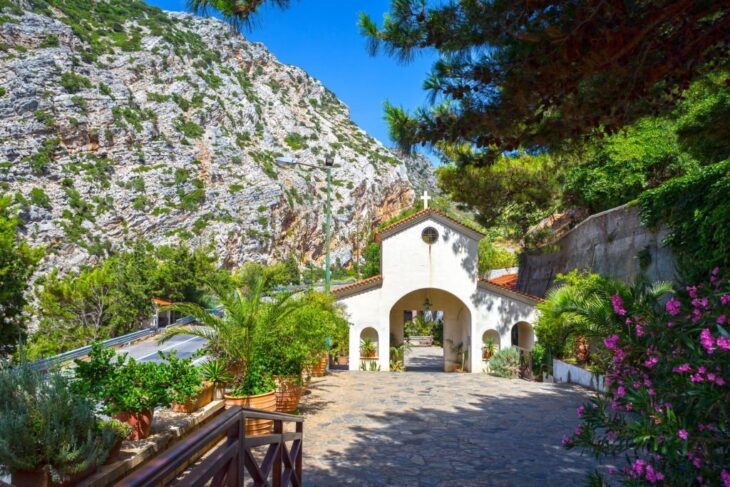
Selinari Monastery is not only a place of religious significance but also a testament to the resilience and bravery of the Cretan people.Despite these challenges, the monastery stands proud, symbolizing the indomitable spirit of the Cretan character.
Visitors to Selinari Monastery will be captivated by its serene and peaceful atmosphere. The monastery houses a fine selection of Byzantine icons, showcasing the artistic heritage of the region.
What are the best monasteries in Chania?
Listed below are the best monasteries in Chania.
- Chryssopigi Monastery. Monastery of Chrysopigi lies just outside the town of Chania in western Crete. Founded in the 16th century, it is dedicated to the Virgin Mary. Over its long history, the monastery has experienced periods of prosperity and decline. It was an important spiritual center under Venetian rule but suffered destruction by Ottoman and German forces. Rebuilt as a convent in 1976, today Chrysopigi is home to around 40 nuns who maintain the monastic traditions of icon painting, embroidery and candle making. The monastery is renowned for its organic cultivation methods and environmental education programs. Its katholikon and folk museum display centuries-old relics. Chrysopigi remains a popular pilgrimage site.
- Gouverneto Monastery. Gouverneto Monastery is also known as Our Lady of the Angels. It is one of the oldest monasteries in Crete. It was founded in 1537 and is located on the Akrotiri Peninsula, about 4 kilometers from the Monastery of Agia Triada and 19 kilometers north of Chania. The monastery is built in the style of a castle, with high towers that were designed to protect it from invaders.
- The Agia Triada Tzagaroli Monastery. The Agia Triada Tzagaroli Monastery is a famous and beautiful monastery located on the island of Crete. It was built in the 17th century by the Lavrentios and Ieremias, members of the Venetian Tzagarolos family. The monastery has a splendid architecture with a mix of styles and is surrounded by enchanting courtyards and lush vegetation. It contains the church of Agia Triada and several other buildings, including an old school, library, monk cells, wine cellar and olive oil press. The monastery also houses a fascinating museum with a collection of rare and valuable artifacts. It is considered a highly regarded religious destination in Crete.
- Katholiko Monastery: Katholiko Monastery is an ancient Orthodox monastery nestled in the cliffs of Akrotiri in western Crete. First inhabited by ascetic hermits in the 11th century, it later became an important religious centre. Today, the abandoned monastery is remarkably intact with medieval architecture and frescoes. To reach Katholiko Monastery, visitors must hike 2 miles up stone steps carved through Avlaki Gorge, enjoying stunning sea views. At the top, Katholiko’s peaceful hillside setting and fascinating old stone buildings transport you back centuries. Its remote clifftop location provides a window into the monastic traditions practiced within Crete’s rugged natural beauty.
What are the best monasteries in Heraklion?
Listed below find the best monasteries in Heraklion.
- Agarathos Monastery. Agarathos Monastery is a Greek Orthodox monastery located in central Crete near the village of Sgourokefali. It is one of the oldest monasteries on the island, founded during the Second Byzantine period. According to tradition, it was named after a Jerusalem sage bush (agarathia) under which an icon of the Virgin Mary was discovered. The monastery has a fortified architecture and its main church has two naves dedicated to the Dormition of the Mother of God and Saint Minas. Agarathos played an important role as an educational center and revolutionary hub against the Venetian and Ottoman rulers. Today it remains an active monastery and houses a museum with valuable ecclesiastical relics and icons.
- Savathianon Monastery. Savathianon Monastery is located in a verdant ravine near the village of Rodia in east of Heraklion. It was likely established in the 15th century and has a fortified architecture. The main church has two naves, one dedicated to the Nativity of the Virgin Mary from 1635 and another added in 1950 for the Forty Martyrs. Savathianon suffered attacks during Ottoman rule when it served as a local revolutionary center but was later rebuilt. An old cave church dedicated to St. Anthony lies just outside the main courtyard across a 16th century stone bridge. The monastery is surrounded by lush agricultural areas tended by the resident nuns.
- Monastery Palianis. The Monastery of Paliani is located in Venerato in Crete and is considered one of the oldest monasteries on Crete. It is dating back to the early Byzantine period. The monastery was wealthy and powerful in its early history but was destroyed by the Turks during the Ottoman occupation. The nuns were massacred but the monastery was later restored. Paliani is dedicated to the Assumption of the Virgin Mary and holds a relic of the Holy Coffin as well as a museum with valuable icons, books and relics. The monastery is also home to a sacred myrtle tree which is believed to have miraculous powers. Paliani is open daily from sunrise to sunset for visits.
Lesser-Known Monasteries Worth Visiting in Crete
Find below other less-known monasteries to visit in Crete.
- Agarathos Monastery. Agarathos Monastery, founded in 1655 by monks Irinarchos and Parthenios, stands as a significant Greek Orthodox center near Sgourokefali, 23 kilometers from Heraklion, Crete.
- Kapsa Monastery. Kapsa Monastery, positioned on Crete’s southeastern coast between Makry Gialos and Sitia, originated in the 13th-15th centuries and was named after the nearby cape. Built in Byzantine style, its main church honors St. John the Baptist.
- Katholiko Monastery. Katholiko Monastery, nestled in the Akrotiri cliffs of western Crete, dates to the 11th century as Saint John the Hermit’s retreat. After his death, the caves transformed into a temple and monastery, becoming a prominent Orthodox pilgrimage site.
- Panagia Kera Kardiotissa Monastery. Panagia Kera Kardiotissa Monastery, an active 14th-century site on Crete’s northern coast, lies 27.9 kilometers northwest of Neapoli and 14.8 kilometers south of Dikte village.
Agarathos Monastery
Agarathos Monastery, founded in 1655 by monks Irinarchos and Parthenios, preserves a 17th-century heritage symbolized by its name, “Agarathos,” meaning “excellent” in ancient Greek. Agarathos Monastery is built in the Athos architectural style and blends with the cliffside setting. Despite fire damage, monks restored its structure over centuries. During the 1821 Greek War of Independence, it sheltered rebels and sometimes served as a hospital. Initially accessible only by a steep path, a 1961 road now permits vehicle access to the monastery’s high-altitude location, 538 meters above sea level.
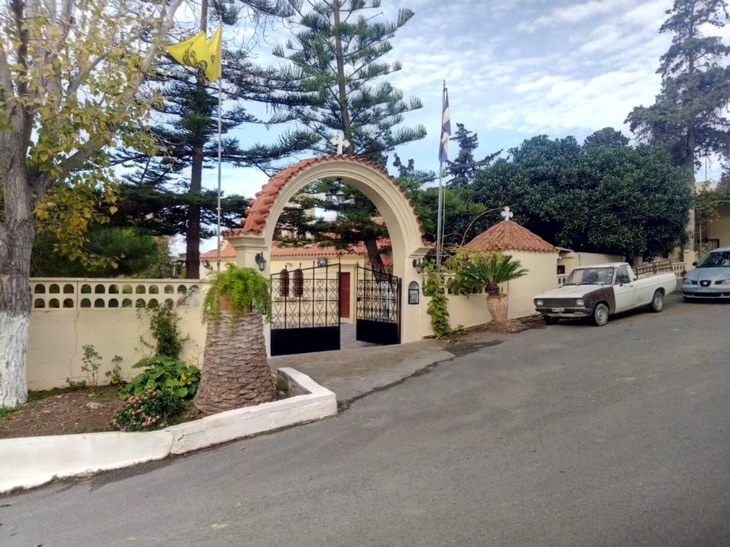
Agarathos Monastery is located near the village of Sgourokefali in the Episkopi municipal unit of Heraklion, central Crete, at an altitude of 538 meters (1.765 feet). It is situated 23 km (14,29 mi) east of Heraklion and its exact coordinates are 35°13′37.7″N , 25°14′58.3″E, placing it in a peaceful, green setting ideal for quiet reflection, away from urban activity.
Agarathos Monastery remains inhabited, with a community of monks dedicated to maintaining its Eastern Orthodox traditions and practices. Over time, Agarathos Monastery, originally known as Roussiko Monastery and later St. Stephen’s Monastery, adopted its current name in the 20th century. Located near Sgourokefali in central Crete, 23 kilometres (14.29 miles) from Heraklion, it serves as an important Greek Orthodox center, housing 19 monks committed to prayer, holy services, and Eastern Orthodox tradition. These monks also work to preserve the monastery’s legacy.
Visitors to Agarathos Monastery should observe respectful etiquette. Dress modestly; avoid short skirts or shorts, and cover shoulders. Women may need to wear long skirts provided by the monastery. Photography is allowed only in designated areas, excluding churches, and flash is not permitted. Politeness dictates asking before photographing monks, with additional restrictions in specific areas.
Kapsa Monastery
Kapsa Monastery, located on Crete’s southeastern coast between Makry Gialos and Sitia, dates back to the 13th-15th centuries and is named after the nearby cape. Built in Byzantine style, its main church is dedicated to St. John the Baptist. Serving as an Eastern Orthodox center for centuries, the monastery was attacked by Ottoman pirates in 1471, leading to its abandonment and decay. Monk Joseph Gerontoyiannis initiated its restoration between 1866 and 1870, reviving its historical and spiritual role. Kapsa Monastery is also know as Moni Kapsa.
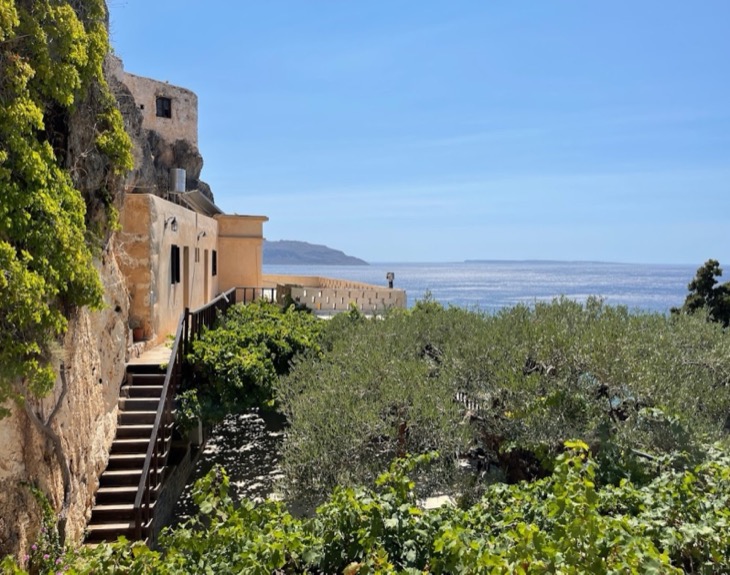
Today, Kapsa Monastery houses a small monastic community dedicated to daily services and property upkeep. Visitors are expected to dress modestly and maintain silence inside the church, though no entrance fee is charged. Spring, especially around Orthodox Easter, is the ideal time to visit. Due to its remote location, rental cars offer the most convenient access.
Nearby attractions to Kapsa Monastery include Kapsa Gorge, Kalami Beach, Ammoudi Beach, Makry Gialos, and Ierapetra. Kapsa Monastery is an active religious community with 15th-century architecture adapted over the centuries. Its oceanside location, historic structures, and tranquil atmosphere attract visitors. Monks enrich the experience by sharing the monastery’s history and pointing out architectural details, making Kapsa an ideal destination for reflection and relaxation.
Katholiko Monastery
Katholiko Monastery, located in the cliffs of Akrotiri in western Crete, is one of the island’s oldest monastic sites, originating in the 11th century as Saint John the Hermit’s refuge. Following his death, the caves he inhabited were transformed into a temple and later a monastery, evolving into a key Orthodox pilgrimage site. Featuring 17th-century medieval architecture, Katholiko includes frescoes and a unique bridge across the gorge, built under Jeremiah Tzagarolo. Though now abandoned, it retains a serene, historical atmosphere. It is accessible from Chania by a 30-minute drive and a 3.2 kilometers (2 miles) hike through Avlaki Gorge. Katholiko Monastery offers views of dramatic cliffs and the sea, inviting visitors to reflect on its centuries-old spiritual and artistic legacy.
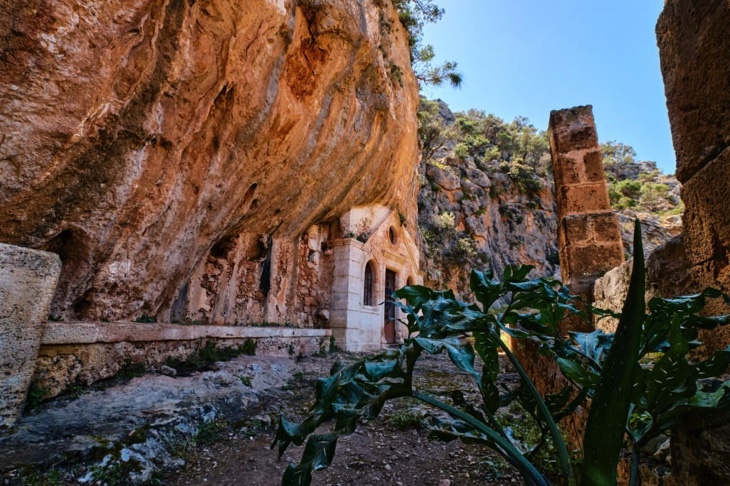
Panagia Kera Kardiotissa Monastery
Panagia Kera Kardiotissa Monastery, a functioning 14th-century landmark on Crete’s northern coast, is 27.9 kilometres (17.34 miles) northwest of Neapoli and 14.8 kilometres (9.2 miles) south of Dikte village. Panagia Kera Kardiotissa Monastery was built under Venetian rule in the late 1300s and is known for its medieval architecture and religious significance. It is accessible by road and attracts both pilgrims and tourists, contributing richly to Crete’s cultural and spiritual heritage.
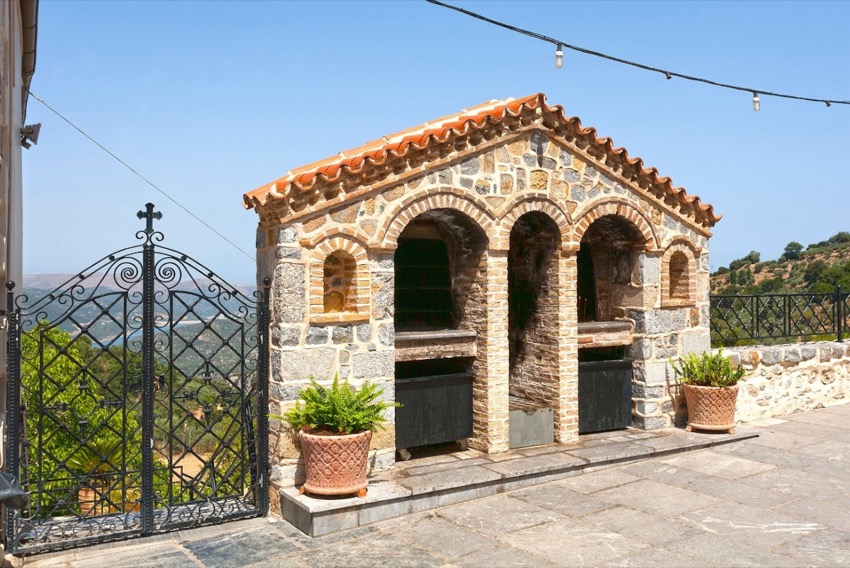
What are the best churches in Crete?
Listed below find the best churches in Crete.
- Panagia Kera in Lassithi. Panagia Kera in Lassithi is one of Crete’s most unique churches, known for its exquisite and best-preserved Byzantine murals. It was built to commemorate the Assumption of the Virgin and has a distinct structure with buttresses supporting the entire building and a refined belfry.
- Cathedral Church of St. Minas. St. Minas Church in Heraklion, these beautiful and majestic churches are must-visit sites. They offer a glimpse into the religious culture of Crete.
- Church in Arkadi Monastery: Located southeast of Rethymnon, this Eastern Orthodox monastery played a significant role in the Cretan struggle against Ottoman rule during the Cretan revolt of 1866. It is situated on a rectangular, lush plateau on the northwest side of Mount Ida in Crete.
What are the best minarets and mosques in Crete?
Listed below are the best minarets and mosques in Crete.
- Küçük Hassan Mosque (Chania): This is the oldest and most mesmerizing Islamic edifice on the island. It is located on the old Venetian port of Chania and is also known as the Mosque of the Janissaries. The mosque was built in 1645 and is painted in elegant white, making it a distinctive landmark.
- Minaret of Ahmet Aga: Minaret of Ahmet Aga is considered an Ottoman architectural treasure. It was named after the commander of Rethymnon’s Turkish occupation forces. The mosque has a four-sided domed tank and two major facades.
- Neratzes Mosque: Neratzes Mosque is located in Rethymno and is known for its beautiful architecture. It is one of the best-known mosques in Crete and is surrounded by lavish gardens and trees.
Can tourists visit Crete’s monasteries and churches?
Yes, tourists can visit monasteries and churches in Crete. While dress codes are relaxed, proper dress is required. No shorts or sleeveless tops. Some monasteries like Preveli require modest skirt coverings. Visitors should also be respectful of worshippers and religious ceremonies taking place. Photographs are typically permitted but may be restricted in certain areas. Overall, Crete’s monasteries welcome tourists interested in Greek history, architecture and orthodox faith.
Can tourists rent a car to get the religious sites of Crete?
Yes, tourists can rent a car to get to the religious sites of Crete. Renting a car provides the flexibility and convenience to explore the various religious sites on the island at your own pace. While public transportation is available, having a car allows you to have more control over your itinerary and visit multiple sites in a day. It is recommended to hire a car in Crete to easily access and navigate the religious sites scattered across the island.
What is the best car rental pickup and drop off location in Crete?
The best car rental location to pickup and return a rental car is always the airports of Crete. These are Heraklion Airport, Chania and Sitia Airport. Most Crete car rental companies offer free delivery and collection on Crete’s airports and prices are cheaper when people hiring a car in airport locations. Car rental companies have cars ready and available at the airports and competition lower the prices.
How much is the daily car rental in Crete cost?
On average, the daily cost for a rental car in Crete falls between €30 to €40. Therefore, an individual seeking to rent a vehicle for an entire week might expect to pay around €250, providing a slightly discounted rate for a longer rental period. For shorter trips, such as a weekend getaway, the average rental cost might tally up to approximately €78. It’s essential to note that the cost can increase or decrease depending on the specific type of car selected. While these average prices offer a baseline, the actual cost of Crete car rental can vary. Therefore, prospective renters are advised to research and compare prices from different rental companies to find a deal that best suits their budget and needs.
Are Greeks religious?
Yes, Greek people have historically been deeply religious, with Greek Orthodoxy being a defining feature of Greek identity and culture. Today around 90-98% of Greeks still identify as Greek Orthodox Christians. However, while identification remains high, religious observance appears to be declining. Only around 17% of Greeks report attending church weekly and 30% pray daily. Many Greeks now view their country as less religious compared to a few decades ago. Around three-quarters see being Orthodox as important to being truly Greek, yet most Greeks also support secular values and oppose government promotion of religion. So while the Orthodox religion remains deeply tied to Greek identity, Greeks increasingly separate faith and nationality. Religious practice is viewed as more of a private matter. Greeks readily joke about religious figures, with irreverent humor towards priests and bishops being socially acceptable. So in summary – while the vast majority of Greeks identify as Greek Orthodox and it remains important culturally, personal religious observance and church attendance are declining and most Greeks also endorse secular values. Religious identity persists, but religious practice does not.
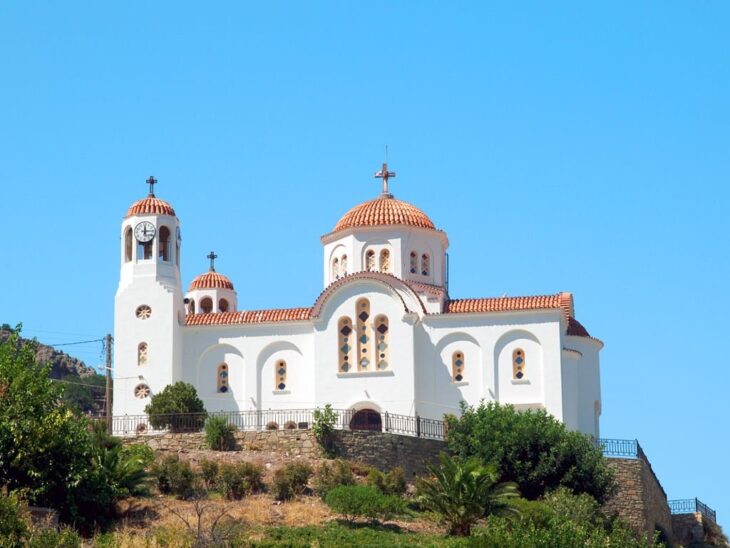
When do Greeks visit the monasteries and churches?
Greeks mostly visit churches and monasteries in the following cases. These are:
- Easter. Easter is a significant and vibrant celebration that goes beyond a single day, encompassing a whole season of religious observances and traditions. It is a time of fasting, contemplation and rejoicing, where communities come together to commemorate the resurrection of Christ with reverence and festive festivities. If in Crete during Easter, one must read Easter in Crete: Traditions, Celebrations and Food.
- Christmas. Christmas in Greece combines religious traditions with folk customs. People attend church services on Christmas Eve and Christmas Day. A feast with roasted pork is traditional. Customs include singing carols called “kalanda”, lighting bonfires and “kallikantzari” where youth dressed as evil goblins dance around villages. The Cretan style of celebrating Christmas is vibrant and filled with unique local culture.
- Epiphany. Epiphany, also known as “Theofania”, is a significant religious celebration that takes place on January 6th. It commemorates the baptism of Jesus Christ in the Jordan River. The highlight of the day is the Blessing of the Waters ceremony, where a cross is thrown into the sea or a body of water and young men dive to retrieve it, symbolizing the purification of the soul. It is a vibrant and festive event that brings communities together to honor this important moment in Christian history.
- Dormition of the Virgin Mary. The Dormition of the Virgin Mary is a major Greek Orthodox festival held on August 15th celebrating the death and resurrection of the Virgin Mary. It is preceded by a two-week fasting period.
- Feast of the Cross Easter. The Feast of the Cross is celebrated on September 14th and commemorates the discovery of the original cross on which Jesus was crucified. It marks the beginning of the ecclesiastical year and a day of strict fasting.
- Name days: Name days celebrating a saint are very important in Greek culture. It’s tradition for Greeks to visit the church named after their saint on their name day.
- Personal religious milestones: Greeks often visit churches and monasteries for baptisms, weddings, funerals and other sacramental services.
- During religious periods like Lent and Advent: Some devout Greeks may attend extra services or go on pilgrimages to important sites during fasting and preparation periods before major holidays.
- Major monastery feasts: Each monastery has a feast day for its patron saint or the Virgin Mary. These draw many pilgrims and visitors.
Can kids visit Crete’s monasteries?
Yes, children are welcome to visit Cretan monasteries and churches. However, there are some etiquette rules that families should follow. Visitors and kids should keep quiet and calm behavior, dress appropriately, don’t touch or disturb worshipers, supervise young children, follow photography rules.
Last updated on January 5th, 2025








